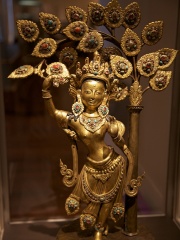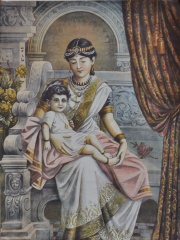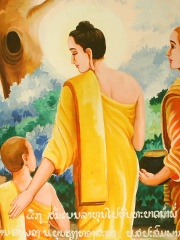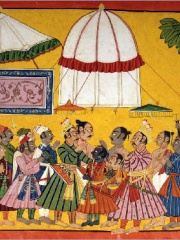



The Most Famous
RELIGIOUS FIGURES from Nepal
This page contains a list of the greatest Nepalese Religious Figures. The pantheon dataset contains 3,187 Religious Figures, 5 of which were born in Nepal. This makes Nepal the birth place of the 61st most number of Religious Figures behind Nigeria, and Colombia.
Top 5
The following people are considered by Pantheon to be the most legendary Nepalese Religious Figures of all time. This list of famous Nepalese Religious Figures is sorted by HPI (Historical Popularity Index), a metric that aggregates information on a biography's online popularity.

1. Maya (600 BC - 600 BC)
With an HPI of 77.09, Maya is the most famous Nepalese Religious Figure. Her biography has been translated into 41 different languages on wikipedia.
Maya (; Devanagari: माया, IAST: māyā), also known as Mahāmāyā and Māyādevī, was Queen of Shakya and the mother of Siddhartha Gautama, better known as the Buddha. She was the wife of Śuddhodana, the king of the Shakya kingdom. She died days after giving birth and the Buddha was raised by her sister, Mahāpajāpatī Gotamī, who became the first Buddhist nun ordained by the Buddha. In the Buddhist Commentaries, Maya was on a traditional journey to her familial home in Devadaha where she would give birth, but her labor started as they were in Lumbini. The Buddha was then born in the gardens and Maya died soon after the birth of the Buddha, generally said to have been seven days afterwards. Maya was then reborn, or came to life again, in a Buddhist heaven, a pattern that is said to be followed in the births of all Buddhas. Thus Maya did not raise her son, who was instead raised by her sister and his maternal aunt, Mahapajapati Gotami. Maya would, however, on occasion descend from Heaven to give advice to her son. Māyā (माया) means "skillful creator" in Sanskrit. Māyā is also called Mahāmāyā (महामाया, "Great Māyā") and Māyādevī (मायादेवी, "Queen Māyā"). In Chinese, she is known as Móyé-fūrén (摩耶夫人, "Lady Māyā"), in Tibetan she is known as Gyutrulma and in Japanese she is known as Maya-bunin (摩耶夫人). Also, in Sinhalese she is known as මහාමායා දේවී (Mahāmāyā Dēvi). In Burmese, she is known as Médaw Maya (မယ်တော်မာယာ, Mother Māyā), Maya Dewi (မာယာဒေဝီ, Māyādevī), Mé Maya (မယ်မာယာ, Lady Māyā), Mahamaya (မဟာမာယာ) and Thiri Mahamaya Dewi (သီရိမဟာမာယာဒေဝီ, Srī Mahāmāyā Devī).

2. Mahapajapati Gotami (600 BC - 480 BC)
With an HPI of 73.12, Mahapajapati Gotami is the 2nd most famous Nepalese Religious Figure. Her biography has been translated into 30 different languages.
Mahāprajāpatī Gautamī (Sanskrit: महाप्रजापति गौतमी; Pali: Mahāpajāpatī Gotamī) or simply Prajāpatī was the foster-mother, step-mother and maternal aunt (mother's sister) of the Buddha. In Buddhist tradition, she was the first woman to seek ordination for women, which she did from Siddhartha Gautama directly, and she became the first bhikṣuṇī (Buddhist nun).

3. Rāhula (534 BC - 500 BC)
With an HPI of 71.96, Rāhula is the 3rd most famous Nepalese Religious Figure. His biography has been translated into 35 different languages.
Rāhula (born c. 534 BCE or 451 BCE) was the only son of Siddhārtha Gautama, commonly known as the Buddha, and his wife, princess Yaśodharā. He is mentioned in numerous Buddhist texts, from the early period onward. Accounts about Rāhula indicate a mutual impact between Prince Siddhārtha's life and the lives of his family members. According to the Pāli tradition, Rāhula was born on the day of Prince Siddhārtha's renunciation, and was therefore named Rāhula, meaning a fetter on the path to enlightenment. According to the Mūlasarvāstivāda tradition, however, Rāhula was only conceived on the day of Prince Siddhartha's renunciation, and was born six years later, when Prince Siddhārtha became enlightened as the Buddha. This long gestation period was explained by bad karma from previous lives of both Yaśodharā and of Rāhula himself, although more naturalistic reasons are also given. As a result of the late birth, Yaśodharā needed to prove that Rāhula was really Prince Siddhārtha's son, which she eventually did successfully by an act of truth. Historian H.W. Schumann has argued that Prince Siddhārtha likely conceived Rāhula and waited for his birth, to be able to leave the palace with the king and queen's permission (having produced a Crown Heir as necessary for succession). However, Orientalist Noël Péri considered it more likely that Rāhula was born after Prince Siddhārtha left his palace. 12 years after Rahula's birth, the Buddha returned to his hometown, where Yaśodharā had Rāhula ask the Buddha for the throne of the Śākya clan. The Buddha responded by having Rāhula ordained as the first Buddhist novice monk. He taught the young novice about truth, self-reflection, and not-self, eventually leading to Rāhula's enlightenment. Although early accounts state that Rāhula died before the Buddha did, later tradition has it that Rāhula was one of the disciples that outlived the Buddha, guarding the Buddha's Dispensation until the rising of the next Buddha. Rāhula is known in Buddhist texts for his eagerness for learning, and was honored by novice monks and nuns throughout Buddhist history. His accounts have led to a perspective in Buddhism of seeing children as hindrances to the spiritual life on the one hand, and as people with potential for enlightenment on the other hand.

4. Anuruddha (b. 450 BC)
With an HPI of 64.45, Anuruddha is the 4th most famous Nepalese Religious Figure. His biography has been translated into 20 different languages.
Anuruddha (Sanskrit: अनुरुद्ध; Pali: Anuruddha) was one of the ten principal disciples and a cousin of Gautama Buddha.

5. Janaka (b. 0)
With an HPI of 60.57, Janaka is the 5th most famous Nepalese Religious Figure. His biography has been translated into 24 different languages.
Janaka (Sanskrit: जनक, IAST: Janaka) is the King of Videha who ruled from Mithila, in the Hindu epic he is brahmin by caste and a very knowledgeable man in the epic Ramayana. Janaka was married to Sunayana. He is the father of Sita and Urmila in the epic. The term Janaka was also the title adopted by all the kings of Videha, who were the descendants of the King Nimi and his son King Mithi. The King Mithi is considered as the first King of Videha who was titled with the term Janaka. Janaka is revered as being an ideal example of non-attachment to material possessions. He was intensely interested in spiritual discourse and considered himself free from worldly illusions. His interactions with sages and seekers such as Ashtavakra and Sulabha are recorded in the ancient texts.
People
Pantheon has 5 people classified as Nepalese religious figures born between 600 BC and 0. Of these 5, none of them are still alive today. The most famous deceased Nepalese religious figures include Maya, Mahapajapati Gotami, and Rāhula.
Deceased Nepalese Religious Figures
Go to all RankingsMaya
600 BC - 600 BC
HPI: 77.09
Mahapajapati Gotami
600 BC - 480 BC
HPI: 73.12
Rāhula
534 BC - 500 BC
HPI: 71.96
Anuruddha
450 BC - Present
HPI: 64.45
Janaka
HPI: 60.57

